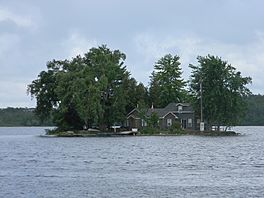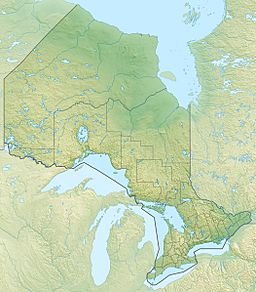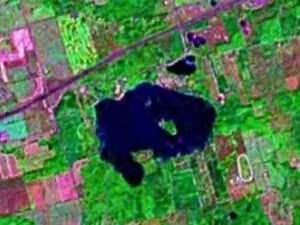Puslinch Lake facts for kids
Quick facts for kids Puslinch Lake |
|
|---|---|

Island on Puslinch Lake
|
|
| Location | Ontario |
| Coordinates | 43°25′2.6″N 80°15′56.3″W / 43.417389°N 80.265639°W |
| Type | Kettle |
| Catchment area | 9.725 km2 (3.755 sq mi) |
| Basin countries | Canada |
| Max. length | 2.012 km (1.250 mi) |
| Max. width | 0.805 km (0.500 mi) |
| Surface area | 1.56 km2 (0.60 sq mi) |
| Average depth | 1.4 m (4 ft 7 in) |
| Max. depth | 5.5 m (18 ft) |
| Water volume | 2,270,000 m3 (1,840 acre⋅ft) |
| Surface elevation | 303 m (994 ft) |
| Settlements | Puslinch, Ontario |
Puslinch Lake is a special type of lake called a kettle lake. It is found in Wellington County, Ontario, Canada. In fact, it is the largest kettle lake in all of Canada!
Even though the lake is considered "private" by the local government, the Township of Puslinch is working to create a way for everyone to visit it. Right next to the lake is the Puslinch Lake - Irish Creek Wetland. This area is very important for nature in the province.
Contents
How Puslinch Lake Gets Water
Puslinch Lake gets its water from rain, melting snow, and springs under the ground. There are no big rivers or streams that constantly flow into it.
Sometimes, small streams that only flow after heavy rain bring water into an area called Mud Bay. When there is a lot of water in the lake, it flows out into Puslinch Lake Creek. This creek is part of the larger Grand River system.
There is also a channel that connects Puslinch Lake to a smaller lake nearby called Little Lake. However, water only moves through this channel when the lake levels are very high.
Lake Life and Health
Puslinch Lake is not very deep. Most of it is less than 2 meters (about 6.5 feet) deep. The deepest spot is only about 5.5 meters (18 feet). Because it is shallow and does not have much water flowing in or out, the lake is changing.
The lake is going through a natural process called eutrophication. This means it is getting more nutrients, which can lead to lots of algae growing. This is called an algal bloom. When there is too much algae, the oxygen levels in the water can drop, which can sometimes cause fish to die.
People living around the lake have changed a lot of the shoreline. This has sped up the natural changes in the lake. Over time, a thick layer of organic material has built up at the bottom. To help with this, people have tried to dredge the lake. This means removing the extra material from the bottom.
The material removed from the lake is put into special bags. These bags let the water drain out, leaving behind dried material. This dried material can then be sold as good quality topsoil to help plants grow.
Fish in the Lake
You can find 16 different kinds of fish in Puslinch Lake. Some of these fish were brought to the lake by people.
One special fish found here is the banded killifish. Puslinch Lake is one of the few places in the entire Grand River area where these fish live.
History of Puslinch Lake
People started settling around Puslinch Lake in the 1830s. The first settlers were Peter and Alex Lamont in 1831.
In 1846, a small church was built on Big Island in Puslinch Lake. Later, in the 1850s, this church was turned into a hotel, but it did not last long.
A Popular Spot for Fun
By 1867, Puslinch Lake was a popular place for picnics. Many people came for day trips. In the 1870s, boat races became a big attraction on holidays.
A famous brewer named George Sleeman bought land around the lake in the 1800s. He eventually owned a large area, including some land near Little Lake. By the late 1880s, Puslinch Lake had become a favorite summer spot for people from nearby areas.
Sleeman built the Puslinch Lake Hotel in 1880. He also bought a steamboat for the lake, which operated until 1883. Other hotels had been built before his by Alex Parks and Thomas Frame.
Changes Over Time
After Sleeman faced money problems, the City of Guelph took over his properties at the lake in 1903. In the late 1920s, the city sold the land for people to build private cottages.
A popular resort area called Barber's Beach was developed in the 1920s by T. Ross Barber. He brought in sand to create the beach. He also added a changing room, a bowling alley, and a large building with a dance floor. This spot was popular for many years and eventually had 100 trailer sites and some cottages. In 2000, the property was sold and became an area of fancy homes called Irish Creek Estates.
Other people also owned land around the lake. Businessman J.W. Lyon divided his land into 42 lots in 1916, and most were sold by 1932. The Eagle family owned land at the east end of the lake for many years. In 1920, much of their land became a subdivision called Eagle Park. These developments meant that Puslinch Lake now had both private cottages and places that the public could visit.
In 1997, property owners around the lake formed a group called the Puslinch Lake Conservation Association. Their main goal is to help protect and restore the environment of the lake.
As of early 2021, the Township of Puslinch Web site stated that Puslinch Lake is a public lake, even though there wasn't a formal public access point at that time.
Images for kids





